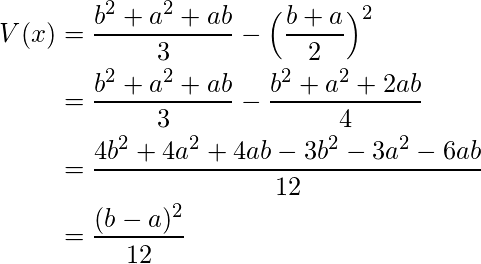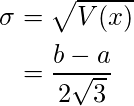Mathematics | Probability Distributions Set 1 (Uniform Distribution)
Last Updated :
01 Mar, 2024
Prerequisite – Random Variable
In probability theory and statistics, a
probability distribution is a mathematical function that can be thought of as providing the probabilities of occurrence of different possible outcomes in an experiment. For instance, if the random variable

is used to denote the outcome of a coin toss (“the experiment”), then the probability distribution of

would take the value 0.5 for

= heads, and 0.5 for

= tails (assuming the coin is fair).
Probability distributions are divided into two classes –
- Discrete Probability Distribution – If the probabilities are defined on a discrete random variable, one which can only take a discrete set of values, then the distribution is said to be a discrete probability distribution. For example, the event of rolling a die can be represented by a discrete random variable with the probability distribution being such that each event has a probability of
 .
.
- Continuous Probability Distribution – If the probabilities are defined on a continuous random variable, one which can take any value between two numbers, then the distribution is said to be a continuous probability distribution. For example, the temperature throughout a given day can be represented by a continuous random variable and the corresponding probability distribution is said to be continuous.
Cumulative Distribution Function –
Similar to the probability density function, the
cumulative distribution function 
of a real-valued random variable X, or just distribution function of

evaluated at

, is the probability that

will take a value less than or equal to

.
For a discrete Random Variable,

For a continuous Random Variable,

Uniform Probability Distribution –
The Uniform Distribution, also known as the
Rectangular Distribution, is a type of Continuous Probability Distribution.
It has a Continuous Random Variable

restricted to a finite interval
![Rendered by QuickLaTeX.com [a,b]](https://www.geeksforgeeks.org/wp-content/ql-cache/quicklatex.com-3faa667d869d8d31da4cdb6c7e0a3bd6_l3.png)
and it’s probability function

has a constant density over this interval.
The Uniform probability distribution function is defined as-

 Expected or Mean Value –
Expected or Mean Value – Using the basic definition of Expectation we get –
![Rendered by QuickLaTeX.com \begin{align*} E(x) &= \int \limits_{-\infty}^{\infty} xf(x) dx&\\ &= \int \limits_{a}^{b} \frac{x}{b-a} dx&\\ &= \frac{1}{b-a} \int \limits_{a}^{b} x dx&\\ &= \frac{1}{b-a} \Big[ \frac{x^2}{2}\Big]_{a}^{b}&\\ &= \frac{b^2 - a^2}{2(b-a)}&\\ &= \frac{b + a}{2}&\\ \end{align*}](https://www.geeksforgeeks.org/wp-content/ql-cache/quicklatex.com-6ab28d6e3d1ac632e06629a9d51f0354_l3.png)
Variance- Using the formula for variance-

![Rendered by QuickLaTeX.com \begin{align*} E(x^2) &= \int \limits_{-\infty}^{\infty} x^2f(x) dx&\\ &= \int \limits_{a}^{b} \frac{x^2}{b-a} dx&\\ &= \frac{1}{b-a} \int \limits_{a}^{b} x^2 dx&\\ &= \frac{1}{b-a} \Big[ \frac{x^3}{3}\Big]_{a}^{b}&\\ &= \frac{b^3 - a^3}{3(b-a)}&\\ &= \frac{b^2 + a^2 + ab}{3}&\\ \end{align*}](https://www.geeksforgeeks.org/wp-content/ql-cache/quicklatex.com-1c322ad17ca1bc5270a9b1c974a6a407_l3.png)
Using this result we get –

Standard Deviation – By the basic definition of standard deviation,

References –
Probability Distribution – Wikipedia
Uniform Probability Distribution – statelect.com
Share your thoughts in the comments
Please Login to comment...